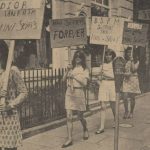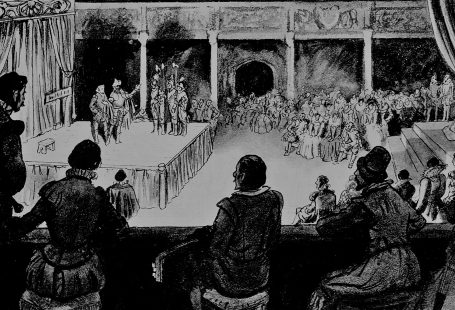This week at The Archive we have added 47,904 brand new pages, and introduced five brand new titles to our collection, which span London’s East and West Ends. From east to west, and from north to south, we have also updated ten of our existing titles over the past seven days.
So read on to discover more about the new titles we have added this week, as well as our updated ones, whilst we tell the story of the tragic Staplehurst rail crash, which took place in 1865 and involved one of the Victorian era’s biggest celebrities: Charles Dickens.
Register now and explore the Archive
We begin our new titles of the week with the West London Times. This penny newspaper was printed and published by James Wakeham from Church Street, Kensington, and first appeared on newsagents’ shelves on 16 June 1860.

A Saturday newspaper, the first edition proudly announces how it had engaged the services of Viscount de Montgomery, ‘who will enrich the columns of the West London Times with his talented Prose and Poetical contributions.’ Meanwhile, the publishers of the new Kensington-based newspaper had:
…engaged the services of other Popular Authors, and it is their intention to make their Paper a First-class Family Newspaper, and never to allow anything to be inserted in its columns which would offend the purest taste, or prevent it from becoming a ‘Welcome Guest’ not only ‘Once a Week,’ but ‘All the Year Round,’ to every home in the kingdom.
So, as well as containing ‘interesting literary matter,’ the West London Times would include ‘all the general News of the week, as well as the local News of the Western District of the Metropolis.’ It had the lofty ambition of being ‘one of the best penny-papers,’ competing with the ‘high-priced Journals’ in terms of the ‘interest and information’ it offered.
The West London Times, therefore, contained the latest news from London’s West, with updates from the Kensington and Chelsea Boards of Guardians, as well as the Chelsea and Hammersmith Vestries. It contained general news items too, featuring ‘Remarks on Passing Events,’ as well as poetry, and the writings of an ‘able Critic’ who was ‘engaged to Review New Works of Fiction.’
Another James Wakeham publication we have joining The Archive this week is the Chelsea & Pimlico Advertiser. Costing just one penny, like the West London Times, the Chelsea & Pimlico Advertiser consisted of four pages and was first published in 1860, and ran with the full title of the Chelsea, Pimlico, and Brompton Advertiser.

Circulating ‘throughout the whole of Chelsea, Pimlico, Brompton, Knightsbridge, Fulham, Kensington, Hammersmith, Notting Hill, Bayswater and Paddington,’ the Chelsea & Pimlico Advertiser was said to sell 10,000 copies a week. A Saturday newspaper, this publication was filled with advertisements and ‘Wanted’ columns, as well as featuring local news from the Chelsea Board of Guardians and the Chelsea Vestry, and guides to nearby exhibitions.
Our final West End title of the week, and another early 1860s publication, is the Westminster Times. Costing one penny, and filling eight pages, the Westminster Times featured both national and international news, as well as ‘Parochial News’ from the local area, which contained the latest again from the Chelsea Vestry, as well as the Kensington Board of Guardians, the Chelsea Ratepayers’ Association and the Hammersmith and Fulham Union.

The Westminster Times also ran general news features, such as ‘The News Budget,’ which was a summary of news, as well as a column entitled ‘Town Talk.’ You can also find within its pages the latest ‘Telegraphic News,’ as well as a wonderful array of illustrated adverts.
From West to East now, and our next new title of the week, which is the East London Advertiser. The East London Advertiser was a Saturday one penny newspaper, which was first published on 29 November 1862. A lively and comprehensive read, the East London Advertiser featured national news, reporting on topics such as the ‘Distress in Lancashire,’ and ‘Destitution in Glasgow.’

It also featured international news, such as the latest from America, and more local news, containing a column entitled ‘London Gossip.’ Meanwhile, within the pages of the East London Advertiser you could find commentary on the latest fashions, poetry, news on ‘Recent Wills and Bequests,’ and various ‘Literary Selections.’
A new and separate version of the East London Advertiser was launched in Stratford in 1869, which continues to be published today as the Docklands and East London Advertiser.
Our final new title of the week is the Kingsland Times and General Advertiser. First published on 7 July 1860, this newspaper appeared every Saturday at the cost of just one half penny. The publishers of the Kingsland Times and General Advertiser aimed to supply ‘a want which has long been felt, and is everyday becoming more urgent.’
They explained in the newspaper’s first edition how:
Without confining our attention to matters purely local, nothing will be omitted, which will bear upon the interests or speak to the sympathies of our own neighbourhood. The Kingsland Times will be a newspaper in miniature, and something more. It will contain a comprehensive epitome of the foreign intelligence and the proceedings in Parliament, the more important law and police cases, occasional notices of new books and serials, the chief news of the district, and the literary, dramatic, and social gossip of the day.

The Kingsland Times and General Advertiser, therefore, had an immensely wide remit, hoping also to prove itself ’eminently useful [to] the tradesman and inhabitants of Kingsland and the locality by which are immediately surrounded.’
Meanwhile, Kingsland was a rapidly changing area. Located in London’s East End, it was once a small village, existing alongside other nearby villages of Dalston and Hackney. With the opening of Dalston Junction in 1865, Kingsland itself became engulfed, and became less of a distinct area, its name surviving in the local street names.
Back to the Kingsland Times and General Advertiser now. It contained local news from the Hackney Board of Guardians, as well as a ‘Weekly Summary’ of news from parliament, the police, and legal happenings. It also featured serialised fiction, such as a story entitled The Peril of the Law or Circumstantial Evidence.

By October 1860, just a couple of months after it was first published, the Kingsland Times and General Advertiser had ‘the largest circulation in the Northern and North-Eastern Districts of any Weekly Newspaper in London.’ By 1862 the newspaper had become known as the Hackney and Kingsland Times, and North-East London Telegraph, now filling eight pages instead of just the four.
That’s all from our new newspapers of the week, and we now turn our attention to our updated ones. Staying in London for just a moment, we have added nearly 20,000 pages to our recent addition the Croydon Times, whilst we have added pages from the 1930 to the 1960s to the Daily News (London). Moving away from the capital, we have also added significant updates to the Liverpool Daily Post and the Sheffield Independent, with updates also to one of our Irish newspapers, the Limerick Reporter.
The Staplehurst Rail Crash
On 9 June 1865, the boat train travelling from Folkestone to London derailed whilst crossing a viaduct at Staplehurst in Kent, resulting in the tragic deaths of ten people, as well as injuries to forty of the passengers. This particular railway crash was all the more infamous because amongst the passengers was Charles Dickens, then aged 53.
But what caused the crash that early June day? Who, if anybody, was to blame? We can find some answers from our new title the Chelsea & Pimlico Advertiser, which as well as publishing survivors’ testimonies, also featured reports from the inquest.
One such report from the inquest, which was held in front of Weald of Kent Coroner William Tanner Neve, gave the account from the railway engine driver, George Crumble. He had worked for the South Eastern Railway company, who ran the ill-fated train, for ten and a half years as a driver, and lived on the Old Kent Road.

Crumble gives his account of the incident, which was precipitated by the unexpected appearance of a signalman, warning of ongoing engineering works a little way up the line:
We left Folkestone at 2.36, and passed all the stations. I do not know the time I passed Headcorn Station, but I kept good time. When I first saw the signalman I was about 350 yards from him. He was in the six-feet way waving a red flag. That was about 150 yards from the bridge. When I saw the signal I shot off the steam, gave the fireman and guard the signal to put on the breaks, secured the engine, and reserved it.
But Crumble did not have enough time to safely stop the train, as he relates:
That was all I could do. I do not think I went over the viaduct at the rate of twelve miles an hour. I cannot say how long it took me to put on the breaks. I knew that repairs were going on, but did not know what they were. I was never cautioned. The signals at Headcorn was ‘all right.’ I do not know that the flag was exhibited before I saw it. We had a beaming sun in our face, and it was very strong. To pull up on that part of the line, at the rate we were going, and with our break power, I should want three-quarters of a mile.

Regulations at the time stated that a signal be shown 1,000 yards before an obstacle. Instead, Crumble was only shown the red flag 554 yards before he was required to come to a stop.
What of the passengers, though, who found themselves suddenly in deadly peril? The Chelsea & Pimlico Advertiser on 24 June 1865 featured ‘a graphic account…from the lips of a lady who was in one of the carriages that went over the bridge, but was miracously saved.’ She described:
…the silence directly after the accident as something awful. A wild shriek would have been a relief. But the carriages kept sinking lower and lower into the mud, and all was as still as death. This lady was rescued when the water was up to her chin!

The Chelsea & Pimlico Advertiser also gives an account of the bravery of writer Chalres Dickens:
He behaved in the most noble manner, and though terribly shaken and nervous, did all he could to alleviate the misery of the sufferers. In his hat he carried clean water to more than one dying person.
Indeed, the Staplehurst railway crash had such an impact on the author that he lost his voice for two weeks afterwards. He was rendered nervous travelling by train, and his son said he never recovered from the crash. Charles Dickens died five years to the day after the accident, on 9 June 1870.

But who was held responsible for the crash? The Chelsea & Pimlico Advertiser on 1 July 1865 reports how the coroner’s jury ‘brought in a verdict of manslaughter against the foreman of the plate-layers and the inspector employed on the spot.’ These were the men employed in the repairs, and responsible for the placing of the signalman. But the newspaper did not necessarily agree with the verdict:
The evidence against these men certainly showed a great want of caution, but punishing plate-layers will not improve railway regulations…The directors themselves should be held responsible for negligence, and then, probably, we should have fewer accidents.

And on 19 August 1865 the Chelsea & Pimlico Advertiser reports on the sentence received by the ‘plate-layer who was to blame in the Staplehurst railway accident,’ which was a nine month prison sentence. The newspaper again blamed ‘persons higher in authority,’ lamenting how it was a ‘pity [that] they should get off scot free.’
Whoever was to blame, however, the Staplehurst railway crash was a tragedy of the industrial age, when railway travel was still relatively new, and we are privileged to find such personal accounts of it within the pages our newspapers.
New Titles
Title | Years Added |
| Chelsea & Pimlico Advertiser | 1860-1863, 1865-1866 |
| East London Advertiser | 1862-1866 |
| Kingsland Times and General Advertiser | 1860, 1862-1863 |
| West London Times | 1860-1861, 1863-1864, 1866-1867 |
| Westminster Times | 1863 |
Updated Titles
This week we have updated ten of our existing titles.
You can learn more about each of the titles we add to every week by clicking on their names. On each paper’s title page, you can read a FREE sample issue, learn more about our current holdings, and our plans for digitisation.
Title | Years Added |
| Albion | 1852 |
| Birkenhead News | 1914 |
| British Banner | 1850-1851, 1854, 1856 |
| Croydon Times | 1934-1947, 1950, 1952-1961 |
| Daily Director and Entr’acte | 1860 |
| Daily News (London) | 1922-1923, 1925, 1927 |
| Limerick Reporter | 1849 |
| Liverpool Daily Post | 1858-1859 |
| Morning Herald (London) | 1808 |
| Sheffield Independent | 1929 |
You can keep up to date with all the latest additions by visiting the recently added page. You can even look ahead to see what we’re going to add tomorrow.






